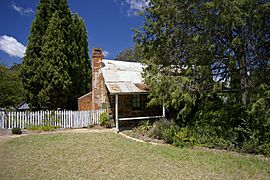Blundells Cottage facts for kids
Quick facts for kids Blundells Cottage |
|
|---|---|

Exterior of the cottage in 2009
|
|
| General information | |
| Status | Complete |
| Type |
|
| Location | Wendouree Dr, Parkes, Canberra, Australian Capital Territory |
| Country | Australia |
| Coordinates | 35°17′35″S 149°08′31″E / 35.293°S 149.142°E |
| Completed | c. 1858 |
| Renovated | c. 1890s; 1960s |
| Client | George Campbell |
| Owner | Commonwealth of Australia |
| Landlord | National Capital Authority (since 1999) |
| Official name: Blundells Farmhouse, Slab Outbuilding and Surrounds, Wendouree Dr, Parkes, ACT, Australia | |
| Type: | Listed place |
| Criteria: | A., B., D., E., H. |
| Designated: | 15 July 2005 |
| Reference #: | 105734 |
Blundells Cottage is a very old stone house in Canberra, Australia. It sits on the northern shore of Lake Burley Griffin. This cottage was built around 1858 by George P. Campbell. He built it for his worker, William Ginn, who was a ploughman (someone who works with a plough to prepare land for farming).
The Ginn family lived here first, followed by the Blundell family, and then the Oldfield family. Each family added to the cottage's history. Today, Blundells Cottage is a special place. It is listed on the Commonwealth Heritage List since 2005. It helps us understand what life was like in the Canberra area long ago.
Contents
The Ginn Family: First Residents
The Ginn family were the first people to live in Blundells Cottage. They called it home from about 1860 to 1874. William Ginn was born in England in 1821. He moved to Australia in 1857 with his wife, Mary, and their two children, Walter and Henry.
William Ginn was a skilled ploughman. He worked for George Campbell at a large farm called Duntroon. Because William was such a good worker, George Campbell built the stone cottage for him in 1860. The Ginn family also rented 90 acres of land to farm.
Two more children, Agnes and Gertrude, were born to William and Mary while they lived at Duntroon. You can see Agnes and Gertrude in an old photograph from that time. William Ginn saved enough money to buy his own land by 1874. He bought 80 acres near Gungahlin and built another stone house. He named his new farm "Canberra Park."
William and Mary lived at "Canberra Park" until William passed away in 1904. Their sons, Walter and Henry, helped them farm the land. Both sons inherited the farm when their father died. Many members of the Ginn family are buried in the churchyard at St John's Church, Reid.
The Blundell Family: A Long Stay
After the Ginn family moved out in 1874, George Campbell rented the cottage to George Blundell. George Blundell was a bullock driver for Campbell. He and his family lived in the cottage for about 60 years!
George Blundell was born in the Canberra area in 1846. His father, Joseph Blundell, had come to Australia as a convict (a person sent to a colony as punishment). Joseph later worked for Robert Campbell, who owned Duntroon before George Campbell.
George Blundell married Flora McLennan. Flora's family came from Scotland. George and Flora moved into Blundells Cottage right after they got married. They had eight children while living there. Flora was a very important person in the community because she was the local midwife. A midwife helps mothers when they are having babies.
The Blundell family grew crops on the land around the cottage. In 1893, a newspaper even mentioned George Blundell's "magnificent crop." The house was known as "Poplar Grove" back then. As their family grew, George and Flora made big changes to the cottage in 1888. They added a new section and a front porch.
George and Flora were well-respected in the Canberra area. Flora passed away in 1917. George lived until 1933. He was even chosen to meet the Duke of York when Parliament House opened in 1927. After George died, the Oldfield family moved into the cottage.
The Oldfield Family: Life on the Farm
Harry Oldfield and his wife, Alice Matilda, moved into Blundells Cottage in 1933. They continued to farm the land. They supplied milk and eggs to people living nearby. Harry was a stockman (someone who looks after livestock) from a place called Yaouk. He was known as a skilled horseman.
Harry passed away in 1942. Alice continued to live in the cottage by herself. In 1957, a magazine called The Australian Women's Weekly wrote an article about people living in Canberra. Alice Oldfield was one of the people they interviewed.
Alice loved living in the old farmhouse. She told the interviewer, "You wouldn't catch me living in any other place." Even though she had to chop a lot of firewood each winter, she was very happy there. The cottage did not even have electricity at that time! Alice passed away in 1958 and was buried at St John's Church in Reid.
Preserving Blundells Cottage
After Alice Oldfield died in 1958, there were plans to tear down the cottage. But a man named Sir William Holford suggested that the cottage should be saved and turned into a museum. This was a great idea!
The National Capital Development Commission helped fix up the cottage. For many years, the Canberra and District Historic Society looked after it as a museum. Today, the National Capital Authority manages Blundells Cottage. It is open to the public, so people can visit and learn about its history.
Blundells Cottage is very important because it is one of the few old stone buildings of its kind still standing in Canberra. It shows us what life was like on a farm in the 1800s. The cottage was added to the Commonwealth Heritage List in 2005. This list helps protect important places in Australia.
Gallery
See also
- Australian residential architectural styles
- Scott's Crossing Road






